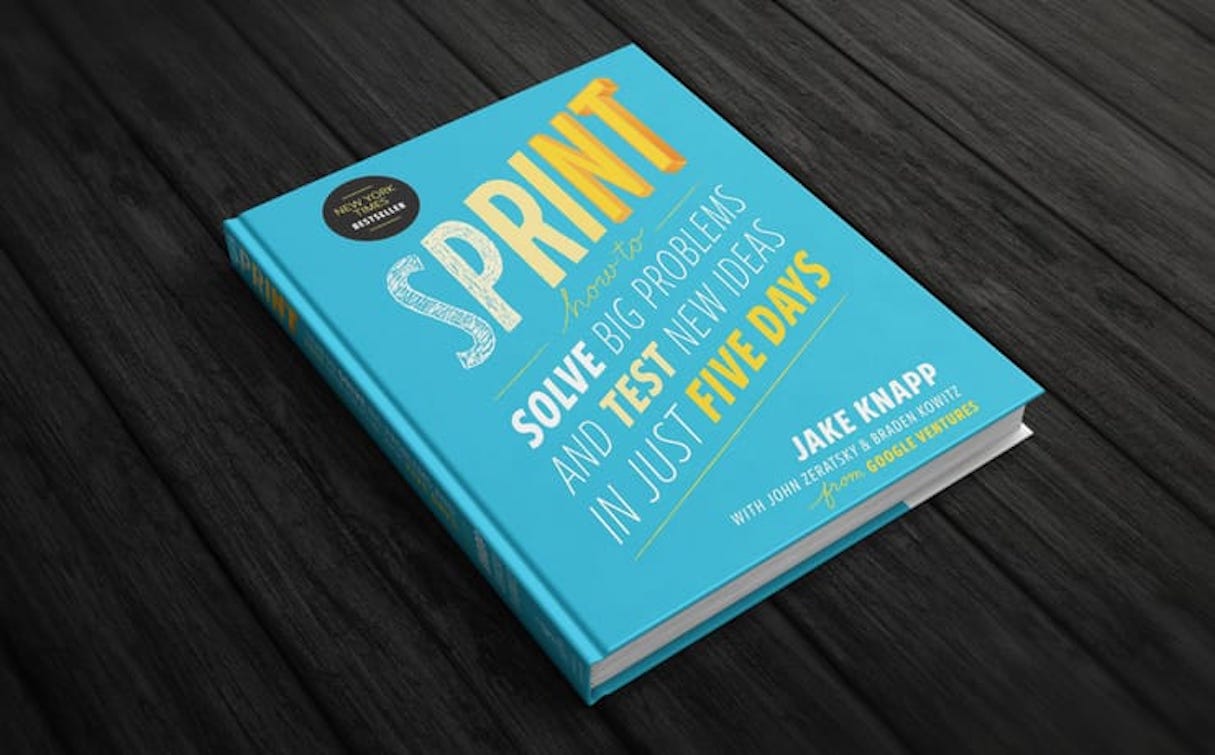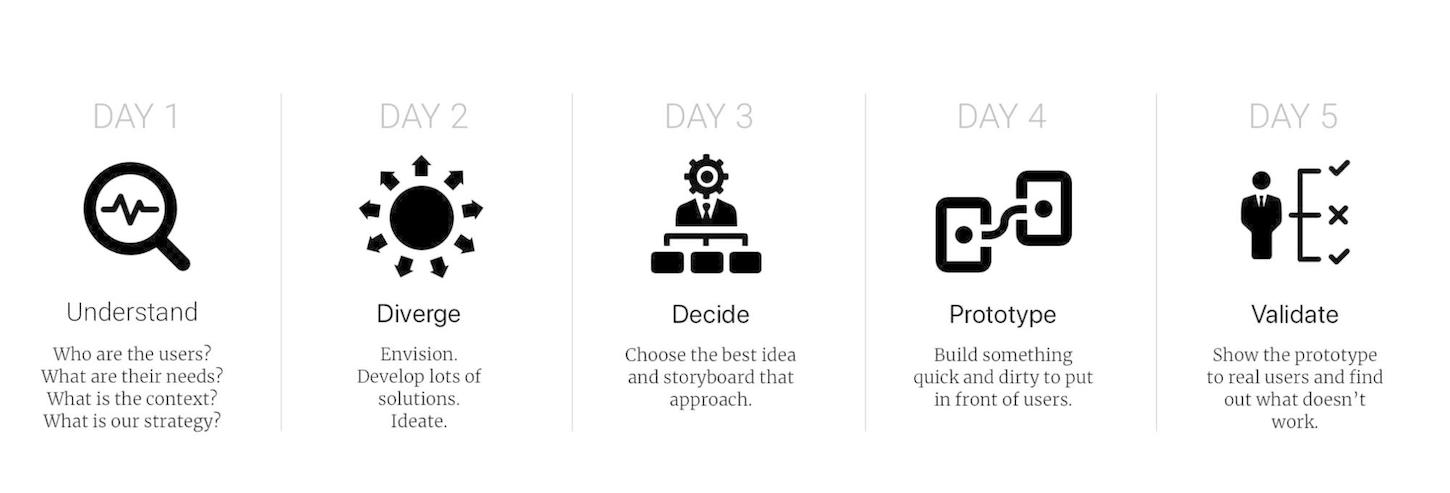Following the publication of the book "Sprint" by Jake Knapp (which became a New York Times Best Seller), there has been a lot of buzz around the idea of design sprints. But what is a design sprint, and should you be running them? Those are the two fundamental questions we seek to unpack in this post.
Let’s begin by looking at precisely what a design sprint is.

What is a design sprint?
Design sprints were born out of Google Ventures, the venture capital arm of Alphabet, Inc. They were initially developed to help startups address business challenges they faced. As the Sprint website says:
“The sprint is a five-day process for answering critical business questions through design, prototyping and testing ideas with customers.”
In many cases, this translates into a way to define and kick off some form of digital project, although Google Ventures has used the technique beyond that field.
Google has created a highly structured five-day process with activities defined for each day, to help participants come up with actionable solutions to their projects. A typical design sprint runs as follows:
- Monday: The group works with experts from across the organization to identify the ultimate goal of the sprint and map out the challenge for the week. Is it to reduce bounce rate? Increase conversion? Identify the problem clearly.
- Tuesday: The team starts exploring a variety of solutions by looking at sources of inspiration and sketching various approaches that they could take.
- Wednesday: The group looks at the solutions explored on Tuesday and decides which ones have the best chance of fulfilling the target for the week. The team then expands those sketched solutions into storyboards.
- Thursday: The group turns the storyboards into a working prototype designed to mimic the final approach and have it ready for testing.
- Friday: The final prototype is shown to prospective users and its viability is tested.

"The whole process is highly interactive, experimental, and user-focused."
The whole process is highly interactive, experimental, and user-focused. In short, it embraces many of the principles of design thinking to produce something tangible with which everybody can agree.
You might also like: Redesigning the Design Process: How to Work More Efficiently in 2020.
The benefits of design sprints
Design sprints are being widely adopted beyond Google Ventures, and with good reason. When organizations approach them in the right way, they have the potential to be very beneficial.
For a start, they break the pattern of committee-based decision making that is so prevalent in many organizations, and moves away from detailed specification documents like a design brief. Instead, design sprints encourage collaboration through making. They are an excellent way of bringing together varying stakeholders and helping them work towards a shared vision.
As a result, sprints are an approach adopted by many agencies when working with new clients. They help the agencies get to know the key players involved, and ensure that everybody knows what they are going to build. Unlike a specification document, a design sprint helps avoid misunderstandings about what the final deliverable will be.
Design sprints also encourage original thinking through experimentation and iteration. Because of their focus on sketching and prototyping, it is possible to explore ideas that would typically be rejected by the company out of hand.
Prototyping and sketching also reduces the cost of failure. You can try new things, and if they don’t work out, that’s okay. Combined with the user testing at the end of the week, this increases the chances of the final solution proving viable in reality.
"When stakeholders are actively involved in creating the solution, they are considerably less likely to reject it later, and more likely to defend it to others."
Then there is the fact that design sprints encourage ownership. When stakeholders are actively involved in creating the solution, they are considerably less likely to reject it later, and more likely to defend it to others. This improves the chances of the solution getting built.
But probably the most valuable benefit of design sprints is that they introduce stakeholders to the importance of validating ideas with real users. Google has orientated the whole week around building a prototype that users find easy to use. That is a valuable lesson for colleagues who can often be more focused on their own agenda, rather than that of the user.
That said, design sprints are not without their challenges.
You might also like: 5 of the Best Prototyping Tools to Test Out Your Web and Mobile Designs.
The challenges of design sprints
The most significant challenge around running a design sprint is getting the right people in the room. Getting people to block a whole week out in their calendar is hard, and finding a week that everybody can do so is even more painful.
The result is that you often end up with more junior staff members in the room, with senior executives only included on Monday when the group speaks to experts. That isn’t a problem in theory, as long as the high-level stakeholders delegate decision making authority to those in the room. However, in my experience, this rarely happens. There is a tendency for the executives to introduce new variables late in the day, undermining the whole process.
Then there is the challenge of managing expectations and scope. Too often the problems faced by the group are too complicated to resolve in a week, and there is no guarantee of success. It’s possible that the prototype does not perform well when tested with users, meaning that the efforts of the week didn’t work out.
All of this means that although design sprints have a lot of potential, they can feel like a significant investment in time for no guaranteed returns. They are also, if I am honest, hard work. Many find them a draining experience.
The question therefore becomes: should you be running design sprints?
You might also like: Color Psychology: How Color Influences Decisions.
Should you be running design sprints?
The answer is a definitive yes. But that doesn’t mean you need to be using design sprints all the time.
Because of their popularity right now, design sprints have started to be seen as somewhat of a silver bullet, but that isn’t the case. They are merely another tool in our arsenal.
When we have a well-defined problem to solve and access to the right stakeholders, a design sprint can prove invaluable. But in other situations, we might be better off running a customer journey mapping workshop or carrying out a collaborative wireframing exercise. It’s about using the right tool for the job.
That said, there are some lessons we can learn from design sprints that are applicable in a far wider variety of situations.
Lessons to learn from design sprints
It is not so much the sprints themselves that are powerful, but rather the underlying principles that Google has built them around. These principles can be used in lots of different contexts outside of sprints. Some of these principles are:
- Favoring collaboration over debate: Too many design decisions are made in meetings, when teams would do better to make decisions by creating something together.
- Involving stakeholders: We often exclude stakeholders for fear of them undermining what we want to achieve. But by including stakeholders, we give them a sense of ownership, and that increases the likelihood of them buying in to the solution.
- Prototyping and experimentation: Avoid spending too much time writing specifications.Instead, explore ideas through prototyping and experimentation. Visualize solutions rather than defining them.
- Always testing with users: Embedding testing with users into the heart of your workflow should be fundamental to any digital project.
Adopt these principles, even outside of the context of a design sprint, and the chances are that you will gain many of the benefits of sprints, without the drawbacks.








